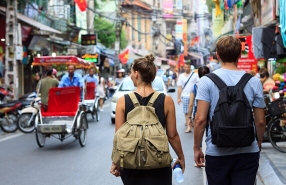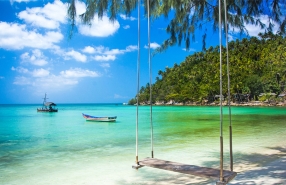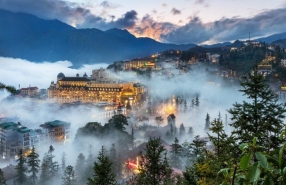Nature Travel In Vietnam In March - Itinerary Review By Leila

Hello everyone! I’m Leila - a lover of getaways where nature guides every step. For my trip to Vietnam - a true experience of nature travel in Vietnam in March, I dreamed of freshness, of landscapes coming back to life after winter, and of that changing light that turns every moment into a discovery. With the help of Autour Asia, an attentive and passionate travel agency, I was able to imagine an itinerary that follows the rhythm of the Vietnamese spring: softer, more alive, more vibrant. In this story, I’m sharing what the month of March offered me: an authentic, soothing Vietnam, perfect for those who are looking for a journey deeply oriented toward nature.
Table of Contents
I. Sapa - Mountains, rice terraces and villages of the Northwest
1. First immersion in the atmosphere of Sapa

From the moment I arrived in Sapa, I was wrapped in a freshness I had never felt before in Vietnam. In March, the air was pure, almost biting, saturated with the smell of damp earth and wet wood. As I walked slowly around the old stone church, I observed H’Mong women carrying their woven baskets, stalls filled with colorful fabrics and clouds lazily sliding between the rooftops. There was nothing really “to do”, but everything to feel: the cold wind on my face, the silence of the mountain, the mist clinging to the slopes - everything one imagined when wondering what to do in Vietnam in March. I simply let Sapa welcome me, at its slow and peaceful rhythm.
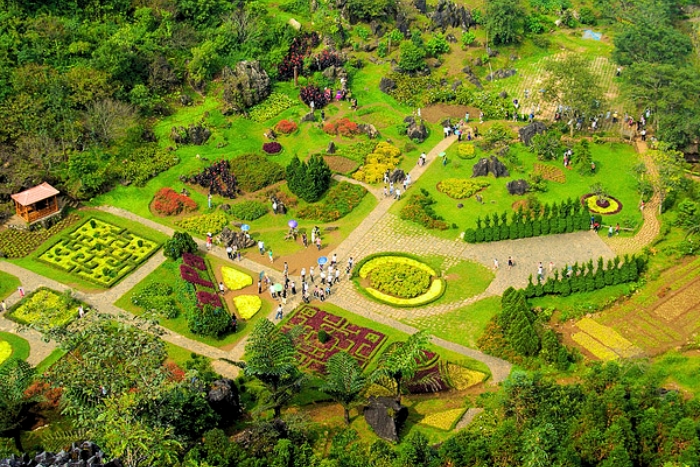
On Mount Ham Rong, the gentle walk became my first real immersion in nature. The mossy path, the increasingly present wind, and the clear view over the Muong Hoa valley created a striking sense of altitude. A simple ascent, but perfect for getting used to the terrain and slowly entering the mountain universe of the North.
2. Hikes in the heart of the valleys and terraced rice fields

The next day, I left the small town of Sapa to go trekking in the Muong Hoa valley, one of the most beautiful natural areas of the region, ideal for a nature travel in Vietnam in March. Very quickly, the walk became a complete immersion: the earthy ground softened each of my steps, the Muong Hoa stream followed part of the trail and I crossed a bamboo bridge before reaching the bamboo area of Y Linh Ho, where the wind made the stems rustle like soft music. The air was fresh, slightly humid and each breath felt purer, fuller.
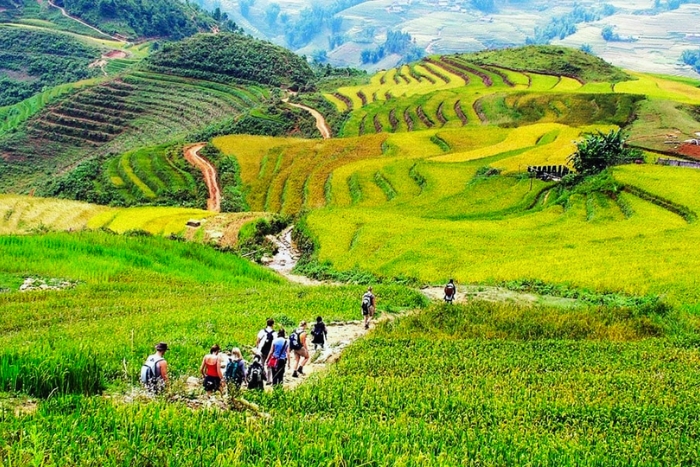
Further down, the trail wound between the terraced rice fields, then reached a small waterfall perfect for a short break. I followed the curves of the path, balanced my steps on narrow passages and felt the slope changing beneath my feet - a simple and immersive way to get a real feel of the Vietnam nature experience in March. This hike was not technical at all: it was lively, fluid, full of simple movements that allowed me to feel nature every minute.
3. Local cultures and daily life in the ethnic villages
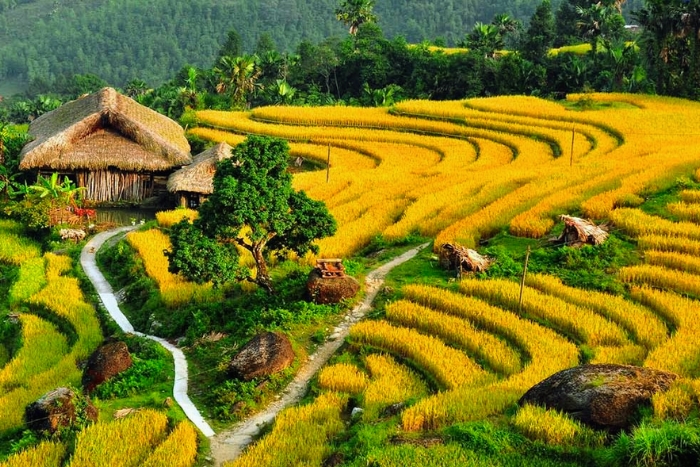
I left Sapa to discover another face of the mountains: that of the villages where daily life still followed the rhythm of the seasons, a beautiful answer to the question of what to do in Vietnam in March. Upon arriving in Ta Phin, nature was no longer just a backdrop: it shaped daily life. Between terraced gardens, paths lined with grasses and slopes where corn grew, I discovered a life paced by the work of the land. The Red Dao women prepared indigo dye in front of their wooden houses and their gestures seemed as natural as the whisper of the wind in the trees. I stopped for a few minutes to listen, observe and breathe - as if culture and nature were responding to each other harmoniously.

Continuing toward Ma Tra and then Sin Chai, two quiet villages where the paths followed narrow streams and gardens planted at the foot of the mountains, I found exactly the spirit of nature travel in Vietnam in March. I walked a little through each hamlet, watched the light slide over the wooden roofs and stopped to drink a cup of hot tea offered with simplicity. Nothing was spectacular, but everything breathed authenticity: nature and human life intertwined effortlessly. It was a gentle, discreet encounter that gave Sapa an unexpected depth.
Read more: Itinerary of 1 week in Sapa
Best things to do in Sapa
II. Ninh Binh and Pu Luong - Karst landscapes and lush valleys
1. Ninh Binh - Sailing between karst peaks and spring rice fields
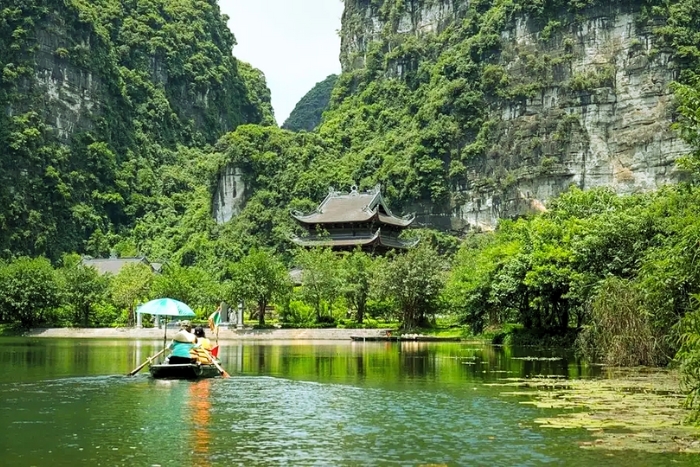
After the mountainous reliefs of Sapa, Ninh Binh welcomed me with a new gentleness - the gentleness of a landscape where water, stone and greenery intertwined effortlessly, perfectly matching the spirit of a Vietnam nature itinerary in March. In Trang An, I boarded a small boat that slipped between the karst peaks like in a natural labyrinth. The oar moved forward with an almost hypnotic calm and each passage under a cave opened onto a wider, brighter scenery. The silence, broken only by the lapping of the water, gave the impression of gliding into an ancient, preserved world where nature spoke in a low voice.
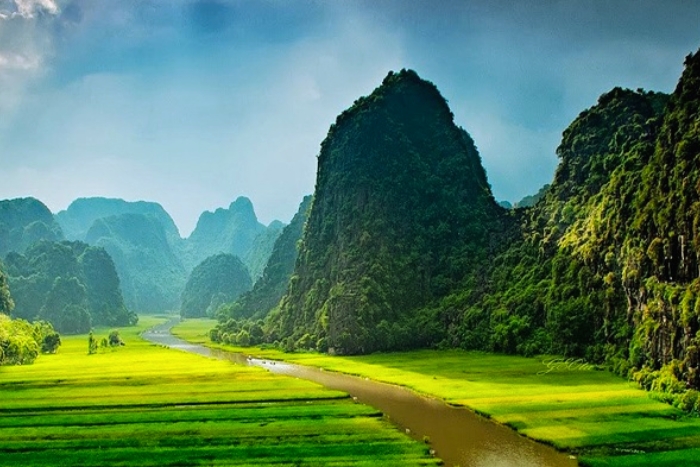
Later, I discovered Tam Coc - more open, more rural, but just as enchanting - an experience that perfectly answered the question of what to do in Ninh Binh. The Ngo Dong River wound through the spring rice fields, a soft green that contrasted with the karst cliffs. The boat quietly followed the current, passed under the three iconic caves and the light played on the water like a silver thread. Here, everything invited me to slow down: the trembling of the rice, the reflections on the river, the breeze that softened the air. Another side of Ninh Binh, different from Trang An, but just as soothing.
Learn more: 5 days in Ninh Binh
2 days in Tam Coc Ninh Binh
2. Panorama from Hang Mua - Discovering Halong Bay on land seen from above
After discovering Ninh Binh from the water, I continued my exploration by gaining height, in one of the best nature places to visit in Vietnam in March. Hang Mua rises just above the rice fields of Tam Coc and to reach its summit, I had to climb a long stone staircase that winds along the mountain. The ascent required effort - especially under the spring warmth - but each pause already offered a new view of the valley. The wind became stronger, the air clearer and the perspective gradually opened up, as if the landscape had decided to reveal itself step by step.
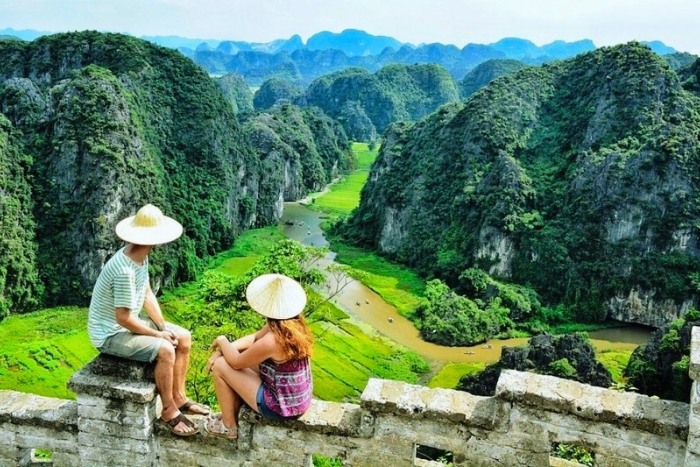
When I finally reached the summit, the panorama almost took my breath away. The Ngo Dong River traced a winding path through the rice fields, while the karst peaks rose from the plain like an army of motionless giants. Below, the boats of Tam Coc glided quietly, tiny from this height. Along the ridge, the silhouette of the stone dragon seemed to watch over the entire Halong Bay on land. Faced with this majestic landscape, I realized everything a nature travel in Vietnam in March could reveal: a vast, calm and deeply enchanting Vietnam.
3. Pu Luong - Untouched nature and the hospitality of the Thai minorities
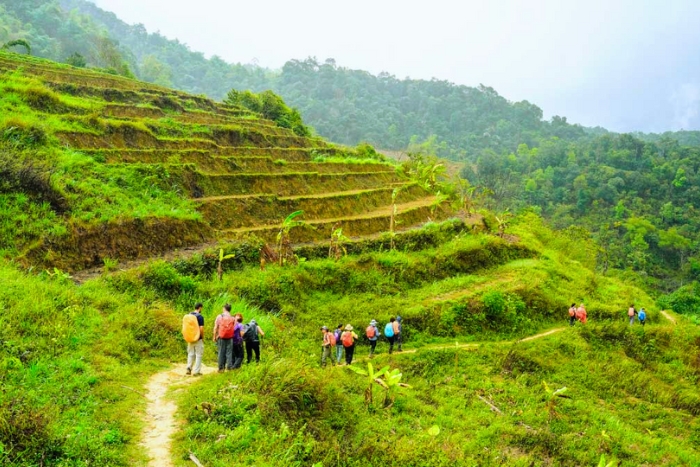
Leaving the aquatic landscapes of Ninh Binh, the road to Pu Luong gradually plunged me into a wilder nature, revealing one of the most authentic sides of March nature travel in Vietnam. The karst peaks disappeared, replaced by hills covered with bamboo and terraced rice fields stretching all the way to the horizon. From the moment I arrived, I felt that the exploration truly began: the trails invited me to walk, to descend into the valley, to follow the gentle rhythm of the Thai villages nestled in the folds of the hills. Here, the landscape was not only contemplative - it called to be lived.
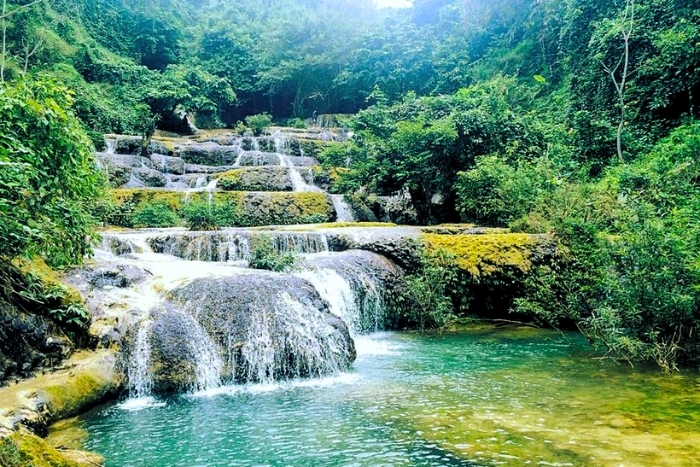
I set out on the paths connecting Ban Don, Kho Muong and Ban Hieu, crossing forests where the light filtered through the leaves and the air carried the scent of damp grass. The murmur of the water guided me to Hieu Waterfall, whose natural basins offered a refreshing break. Further on, the large bamboo water wheels turned slowly at the edge of the rice fields, a testament to ancestral know-how. In the evening, welcomed into a stilt house, I shared a simple yet warm meal. In Pu Luong, every activity - walking, listening, pausing - became a complete immersion in an untouched and living nature, just as one imagines in a nature travel in Vietnam in March.
III. Mekong Delta - River life, orchards and the softness of the South
1. Immersion in the bustle of the floating markets
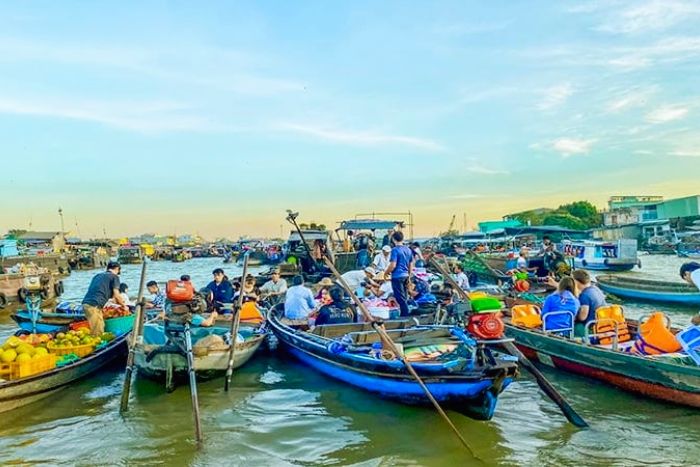
After the reliefs of the North and the peaceful valleys of the center, the Mekong Delta offered me an experience entirely oriented toward water, perfectly aligned with the spirit of a trip to Vietnam in March. At dawn, I boarded a small boat to reach the Cai Rang floating market. The morning freshness brushed against my skin, the boat glided gently over the waves and I immediately felt that everything here began with the movement of the river. The farther I went, the more the scene came to life: dozens of boats appeared, each loaded with fresh fruits and vegetables, ready for a new day of trade.
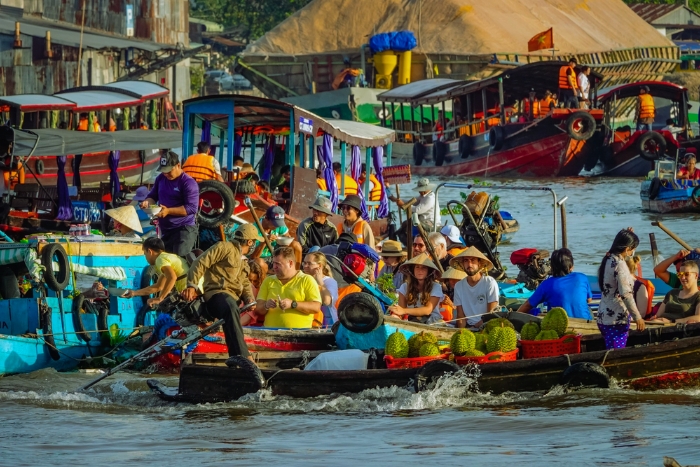
Navigating through the heart of the market became a true immersion, a scene that made perfect sense within a nature travel experience in Vietnam in March. I slipped between the boats, watched the vendors lift their products to the top of a long pole used as an indicator and felt the living rhythm of the river in every gesture: grabbing a rope, pushing a boat, greeting someone with a wave of the hand. The most beautiful moment was perhaps when I stopped to enjoy an iced coffee and a bowl of hủ tiếu prepared directly on a small boat-kitchen. Eating, drinking, moving, observing - here, every activity took place on the water. And it was this total closeness to the river that made the experience so unique, so intensely alive.
2. Sampan ride through the shaded canals
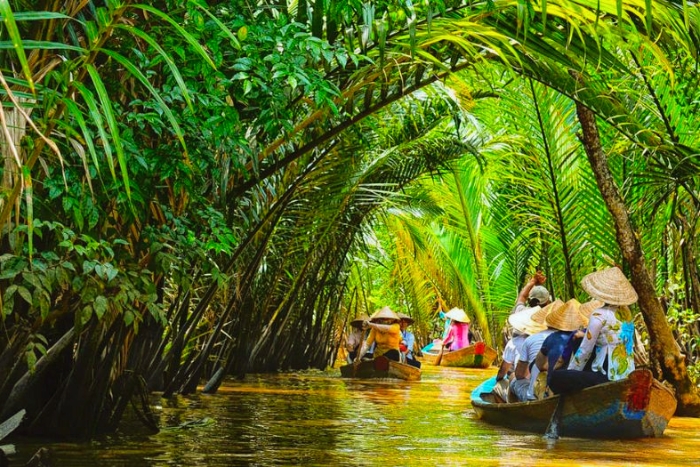
Boarding a sampan in Ben Tre, I glided gently just above the water, rocked by the steady rhythm of the paddle. The water palms formed a green tunnel above me and the air grew cooler as the canal narrowed - exactly what one imagines during a nature travel in Vietnam in March. At one point, I was allowed to try a few strokes of the paddle: a simple, almost meditative gesture that made me feel as though I were breathing at the same rhythm as the Mekong. The boat moved forward in silence, brushed past roots and slipped under small wooden bridges - an intimate immersion in the shaded canals of the delta.
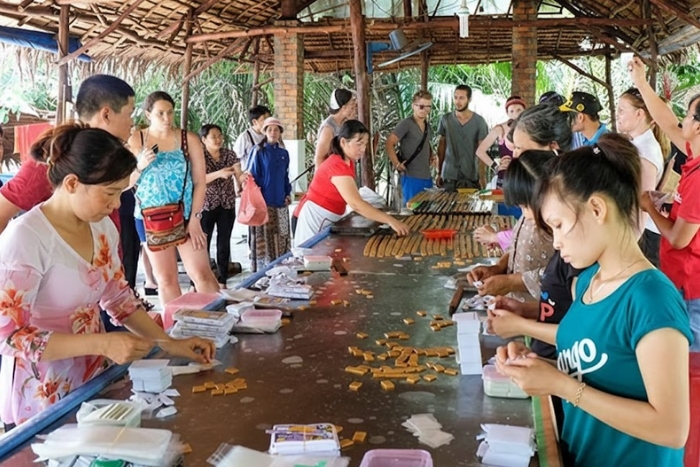
When I docked at the edge of the canal, the trip naturally continued by bicycle - a beautiful way to understand what to do in Ben Tre beyond boating. I pedaled slowly along shaded paths lined with coconut trees, always guided by the presence of water. A little farther on, I stopped at an artisanal coconut candy workshop set right by the rach (canal). There, I observed the quick, precise gestures: grating fresh coconut, stirring the fragrant caramel, cutting the still-warm squares. By combining navigation, cycling and local craftsmanship, I discovered a Mekong that was gentle and alive, always rooted in its canals and in the peaceful rhythm of the river.
Also read: 5 days in Ben Tre
What to do in Ben Tre in 2 days
3. Tropical orchards and Mekong gastronomy
In the tropical orchards of the Mekong, I discovered an experience where nature was lived through simple gestures - exactly what one looks for during a nature travel in Vietnam in March. I walked between the fruit-laden trees, observed up close the mangoes, rambutans and pomelos still hanging from the branches, and learned how to choose a fruit at perfect ripeness. The most enjoyable moment was when I was invited to pick directly from the tree: the flesh was fresher, more fragrant and I could truly feel the generosity of the land. It was a gentle, authentic activity that allowed me to grasp the agricultural richness of the delta.
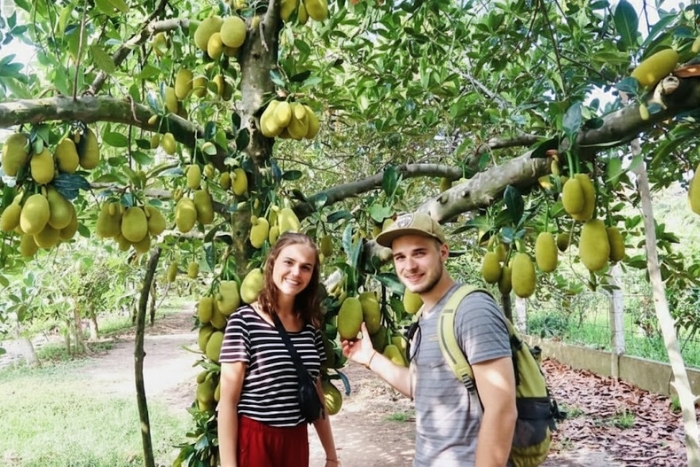
The discovery continued with the local cuisine, prepared on-site from garden produce - a gourmet interlude that fit perfectly into a Vietnam nature itinerary in March. I took part in a small workshop where I cooked a bánh xèo, learned how to roll the crêpe with aromatic herbs and then watched river fish slowly grilling. The meal was simple but remarkably fresh: fragrant salads, crunchy vegetables and a freshly opened coconut. Between fruit picking, culinary gestures and sharing a meal, I discovered a warm and lively Mekong, where gastronomy remained deeply connected to nature and the seasons.
As I left the Mekong, I realized I had experienced one of the best nature trips in Vietnam in March. From the fresh mist of Sapa to the karst landscapes of Ninh Binh, from the quiet trails of Pu Luong to the shaded canals of the South, each place had offered me a different emotion: a breath, a light and the scent of damp earth. I left with vivid images still in my mind: the dew on the rice fields, the gliding of a sampan, the freshness of a hand-picked fruit. A gentle, vibrant month of March that I keep as a silent invitation to return.
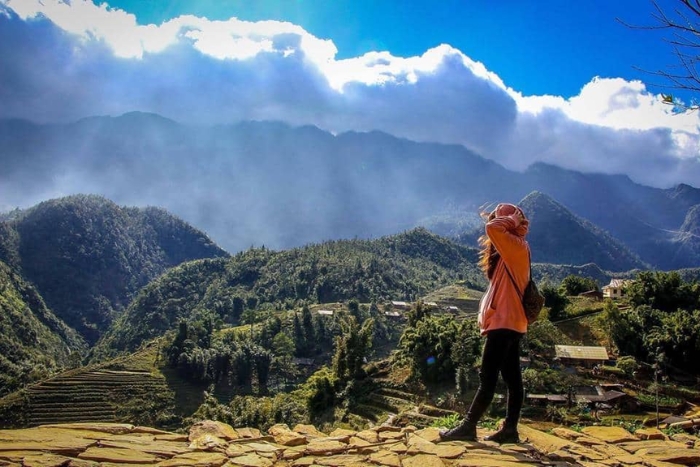
As I closed this nature travel in Vietnam in March, I realized that Vietnamese nature never settles for being just a backdrop: it accompanies, surprises and soothes. From the fresh mists of Sapa to the tranquil waters of Ninh Binh, all the way to the fragrant canals of the Mekong, each place had offered me a different way to slow down and feel. What I remember most is this ability Vietnam has to transform every moment into a sensory experience - a shifting light, a breath of wind, the smell of damp earth. Thanks to Autour Asia, best travel local agency in Vietnam whose thoughtful advice shaped a tailor-made itinerary, I was able to experience a profoundly authentic journey, rooted in both nature and the season. March revealed to me a Vietnam that was alive and vibrant and I already know that these landscapes will stay with me for a long time.
Suggested reads:
- Farming Tours in Vietnam
- How many days is ideal in Vietnam
- How to travel around Vietnam on a budget
- Vietnam Travel Guide
- Vietnam trip 2 weeks itinerary
- Vietnam Tours
Yes, March is truly an excellent time for a nature trip to Vietnam. The weather is mild, pleasant, and rarely unpredictable: the North offers ideal freshness for hiking, Ninh Binh reveals its spring rice fields, and the Mekong is not yet too hot. The landscapes begin to come back to life after winter, the trails are easy to access, and outdoor activities — trekking, boat rides, cycling, orchard visits — can be enjoyed in very good conditions. It’s a month when you can fully embrace nature, with no significant rain and no overwhelming heat, making it perfect for a nature travel in Vietnam in March.
An authentic 2-week trip to Vietnam harmoniously combines nature, culture, and local encounters. The ideal itinerary begins in Hanoi, exploring its historical districts and colonial atmosphere, before heading to Mai Chau and then Pu Luong for gentle hikes through terraced rice fields and ethnic minority villages. The journey continues in Ninh Binh, discovering Van Long, Tam Coc, and its boat rides amid karst landscapes, followed by a magical overnight cruise in UNESCO-listed Halong Bay. Central Vietnam then reveals all its charm: Hoi An and its ancient alleys, Hue and its imperial heritage. Finally, the itinerary ends in the South, between the vibrant modernity of Ho Chi Minh City and a warm stay in the Mekong Delta at the heart of river life. A complete route that captures the soul of Vietnam.
The best itinerary for a weekend at a farm in Vietnam combines agricultural immersion, relaxation, and discovery of local life. The first day can begin on a rural farm: feeding the animals, harvesting vegetables in the garden, and taking part in seasonal activities such as rice farming or corn picking. In the afternoon, a bike ride or a walk through rice fields, orchards, or stilt villages allows you to explore the surrounding landscapes and observe the daily life of local residents. The second day can be dedicated to a cooking workshop using the ingredients you harvested, a visit to village markets or local artisans, or ecological activities such as permaculture or traditional handicraft making. Whether in Sapa, Mai Chau, Tra Que, Dalat, or Ben Tre, this simple yet varied program offers an authentic, friendly immersion perfectly suited for a short farm stay in Vietnam.
Related travel guide
Other similar articles
CUSTOMIZABLE BY LOCAL EXPERTS
Personalized trip at the original price!
REFUND GUARANTEE
We believe in our work and promise to give you money back.
GOOD PRICE / QUALITY
95% satisfied more than expected!
24/7 LOCAL SUPPORT
We are always available online to provide assistance at any time.
Most read articles
Autour Asia is highly recommended on
Embracing the mission of "Satisfied more than expected" and providing authentic experiences, we have received numerous recommendations on reputable travel forums:













